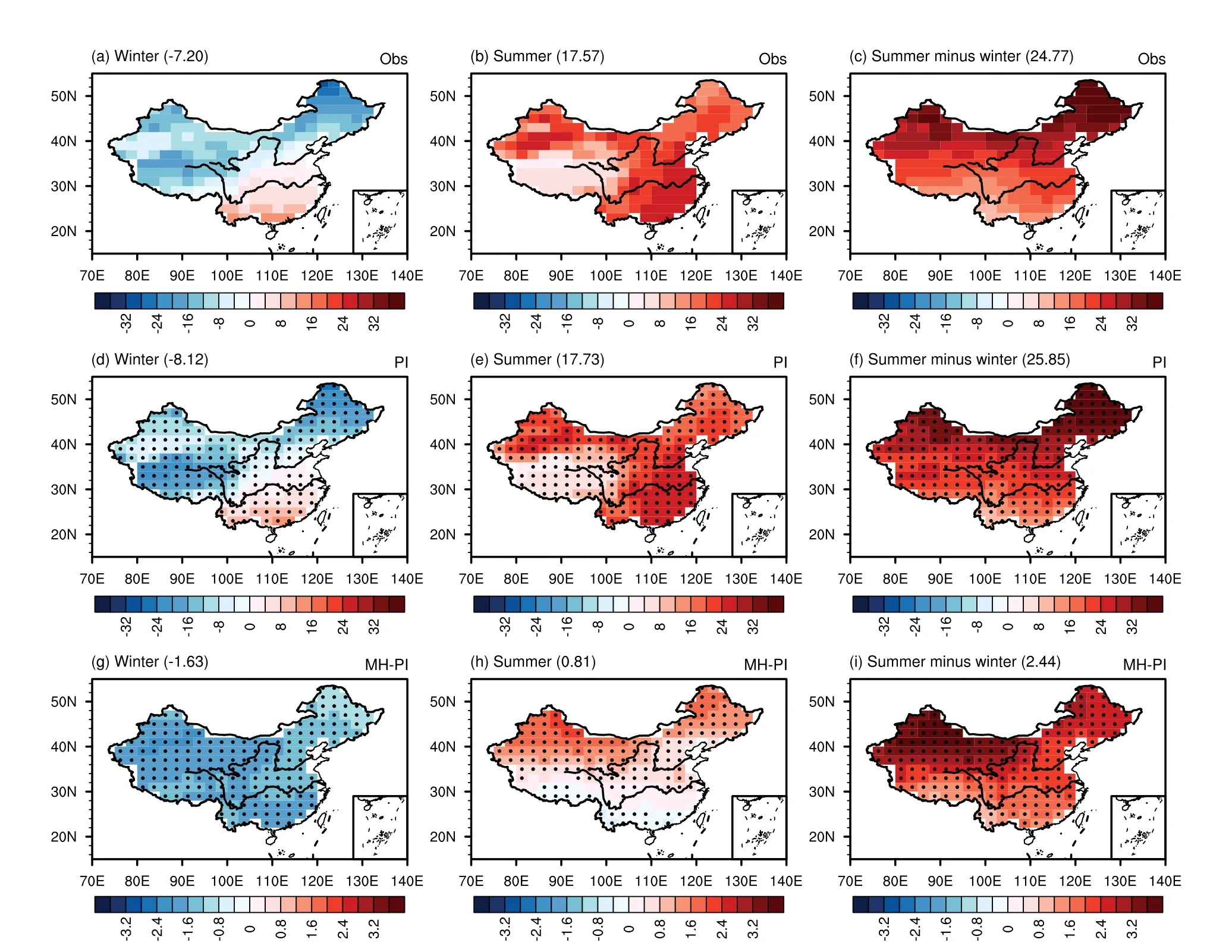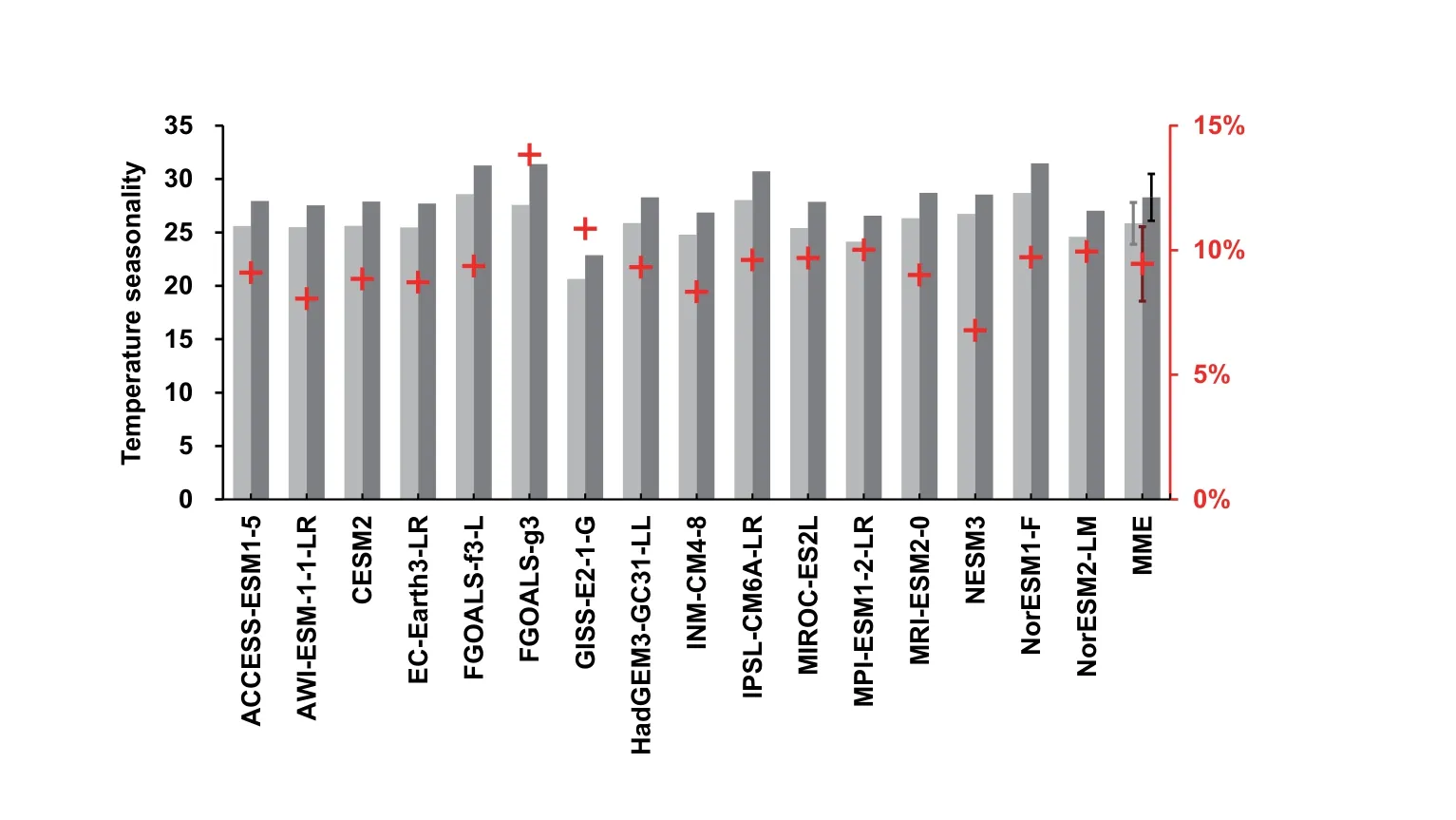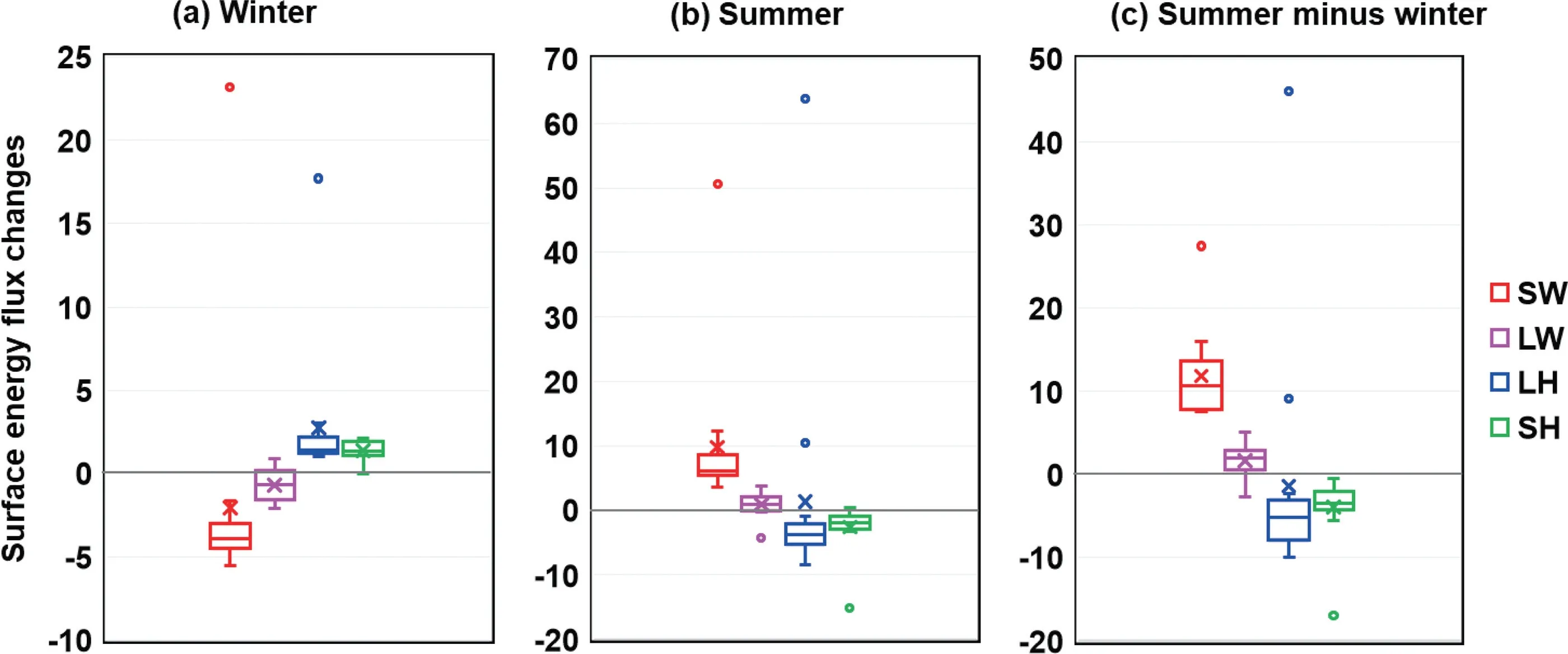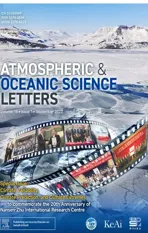Enhanced seasonality of surface air temperature over China during the mid-Holocene
2023-10-11ZhipingTianDabangJiang
Zhiping Tian,Dabang Jiang
Institute of Atmospheric Physics,Chinese Academy of Sciences,Beijing,China
Keywords: Mid-Holocene Temperature seasonality China PMIP4 simulations
ABSTRACT Using all available simulations performed by climate models participating in PMIP4 (Paleoclimate Modelling Intercomparison Project —Phase 4),the authors quantify the seasonality change of surface air temperature over China during the mid-Holocene(6000 years ago)and the associated physical mechanisms.Relative to the preindustrial period,all 16 models consistently show an enhanced temperature seasonality(i.e.,summer minus winter temperature)across China during that interglacial period,with a nationally averaged enhancement of 2.44°C or 9% for the multimodel mean.The temperature seasonality change is closely related with the seasonal contrast variation of surface energy fluxes mainly due to the mid-Holocene orbital forcing.Specifically,the summer—winter increase in surface net shortwave radiation dominates the intensified temperature seasonality at the large scale of China during the mid-Holocene;the surface net longwave radiation has a minor positive contribution in most of the Tibetan Plateau and eastern China;and both the surface latent and sensible heat fluxes show partial offset effects in most of the country.There are uncertainties in the reconstructed temperature seasonality over China during the mid-Holocene based on the proxy data that can reflect seasonal signals.
1.Introduction
Outside the tropics,seasonality is one of the fundamental characteristics for many climate variables (Thomson,1995),among which the seasonality of surface air temperature is characterized by warm summers and cold winters due to changes in the Earth’s orbit that modify the seasonal and meridional distribution of insolation (Berger,1978;Milankovitch,1941).Variations in temperature seasonality can exert significant influences on ecology and society,including agricultural production (Thomson,1995),vegetation productivity (Xu et al.,2013),mammalian fertility (Rosetta,1993),animal migration patterns(Carey,2009),and epidemic spread(Huber et al.,2018).Therefore,investigating the seasonality of surface air temperature is very important for ecological and social developments.
Against the background of global warming mainly due to the continual rise of greenhouse gas (GHG) concentrations,the temperature seasonality has been observed to vary in many regions,such as a reduced amplitude averaged over the Northern Hemisphere during the 20th century (e.g.,Mann and Park,1996;Stine et al.,2009;Wallace and Osborn,2002) and over the Tibetan Plateau (TP) since the 1870s (Duan et al.,2017).Besides,the seasonality of surface air temperature has been projected by climate models to alter during the 21st century,showing a weakened amplitude at the hemispheric scale(Wallace and Osborn,2002)with a decrease in high latitudes but an increase in low and mid latitudes(Chen et al.,2019;Dwyer et al.,2012).As a populous country highly sensitive to climate change,China has experienced an overall decreasing trend of the amplitude of the temperature annual cycle during the period 1961—2007(Qian et al.,2011).This national mean downward trend will probably continue over the 21st century according to future projections,with a spatially robust decrease over the TP and Northeast and Southeast China but an increase over Northwest and central China(Hu et al.,2022).However,the causes of the observed and projected changes in temperature seasonality remain inconclusive,especially at the regional scale,which vary from surface solar radiation change and increasing atmospheric CO2concentrations,to internal climate variability(e.g.,Hu et al.,2022;Mann and Park,1996;Qian et al.,2011;Stine et al.,2009).In this regard,it is necessary to look back into the past to better understand the temperature seasonality change under different climate backgrounds and the physical mechanisms,particularly at the regional scale.
Paleoclimate modeling provides an opportunity to comprehend the climate seasonality under various climate conditions.The mid-Holocene,about 6000 years ago,was an interglacial period with notably different climates and environments from the present (Bartlein et al.,2011),when the global mean surface air temperature was estimated to be approximately 0.2 °C—1.0 °C warmer relative to 1850—1900(Gulev et al.,2021).It has also been one of the benchmark periods to coordinate paleoclimate experiments and model—data comparisons under the framework of the Paleoclimate Modelling Intercomparison Project (PMIP;Joussaume and Taylor,1995).The Earth’s orbital parameters underwent remarkable changes during this period,resulting in an increase (decrease) in the seasonal distribution of insolation in the Northern (Southern) Hemisphere by about 5% (Berger,1978).It is straightforward that this varied insolation seasonality could have led to an overall enhanced seasonality of surface air temperature in the Northern Hemisphere during the mid-Holocene,although it could have been modulated regionally by feedbacks between different components of the climate system.Whether this was the case for all northern latitudes,especially for extratropical China,remains unclear.Previous studies on proxy-based reconstructions and time-slice-based simulations have mainly focused on the mid-Holocene annual and seasonal mean temperatures over China (e.g.,Dong et al.,2022;Jiang et al.,2012;Shi et al.,1993;Tian and Jiang,2015;Wang,2000;Zhang et al.,2022a),with little emphasis on the response of temperature seasonality to the orbital forcing during that period,particularly in a quantitative manner.The present study addresses this issue using all available state-of-the-art climate models participating in phase 4 of PMIP(PMIP4).
2.Data and methods
Sixteen coupled models are available for the mid-Holocene climate simulation in the PMIP4 framework,which have overall higher horizontal resolution than the previous PMIP models.Basic information on those models is provided in Table S1.The main boundary conditions for the mid-Holocene experiment included changes in the Earth’s orbital parameters(Berger,1978)and atmospheric GHGs relative to the preindustrial period (i.e.,1850 Common Era).In PMIP4,the orbital parameters of eccentricity,obliquity,and precession were 0.018682 (0.016764),24.105°(23.459°),and 0.87°(100.33°)during the mid-Holocene(preindustrial period),respectively;the atmospheric concentrations of CO2,CH4,and N2O reduced from the preindustrial levels of 284.3 ppm,808.2 ppb,and 273.0 ppb to 264.4 ppm,597 ppb,and 262 ppb for the mid-Holocene,respectively.Sea surface temperatures were simulated by using coupled atmospheric—oceanic models for both periods.The mid-Holocene vegetation and aerosols were prescribed or interactive as in the preindustrial experiment.More details about the models and experiments are provided by Otto-Bliesner et al.(2017),and are available online at https://pmip4.lsce.ipsl.fr/.Fixed with the above boundary conditions,both experiments have run at least 100 years after reaching quasi-equilibrium states (Table S1).The average for the final 100 years of each simulation was used for analysis.The CN05.1 monthly observational dataset of temperature for 1961—2000 was applied for model evaluation,which is established through in-situ data at 2416 stations over China by the Chinese National Climate Center with a horizontal resolution of 0.5°×0.5°(Wu and Gao,2013).
Considering that the horizontal resolution ranges from approximately 1.25°×0.9°to 2.8°×2.8°among the 16 models,all models and observation data were remapped to a relatively mid-range resolution of 2.5° × 2° (longitude × latitude) using a bilinear (when the original resolution is lower) or area-based interpolation algorithm (when the original resolution is higher) to reduce the error caused by interpolation.The multimodel mean was then obtained from the arithmetic mean of all models.The temperature seasonality is defined by summer (June—July—August) minus winter (December—January—February) surface air temperature in this study,which is widely applied in previous studies(e.g.,Xu et al.,2013;Zhang et al.,2022b).
3.Results
3.1.Temperature seasonality changes during the mid-Holocene
Fourteen out of the sixteen PMIP4 models for the preindustrial experiment have been evaluated against the observation by Tian et al.(2022);similar assessment displays that all 16 models can reproduce the winter and summer temperatures over China for 1961—2000 quite well(Fig.1(a,b,d,e)).As a whole,the simulated large-scale distribution of temperature seasonality over China for the 16-model mean resembles the observation,with a south—north gradient and an average amplitude of 25.85 °C and 24.77 °C,respectively (Fig.1(c,f)).In response to the mid-Holocene orbital forcing mainly due to the precession (Berger,1978),the insolation averaged over China decreased in winter but increased in summer compared to present day (Tian and Jiang,2015).Following this insolation change,all 16 PMIP4 models display consistently colder winter and warmer summer relative to the preindustrial period.As a result,the mid-Holocene temperature seasonality enhanced by an average of 1.81 °C—3.82 °C (7%—14%),with a standard deviation of 0.44°C(1%)across models(Fig.2).In terms of the mean of all 16 PMIP4 models,the winter temperature decreased by 1.63 °C and the summer temperature increased by 0.81 °C,leading to an intensified temperature seasonality by 2.44 °C or 9% averaged over China during the mid-Holocene (Fig.1(g—i)).This value is within the range of 2.10 °C—2.70 °C for the mid-Holocene increase in summer minus winter temperature over China obtained from previous PMIP models(Jiang et al.,2012;Tian and Jiang,2015).

Fig.1.(a,d,g)Winter temperature,(b,e,h)summer temperature,and(c,f,i)temperature seasonality(i.e.,summer minus winter temperature)over China(units:°C) in (a—c) observations for 1961—2000 and in simulations for (d—f) the preindustrial period and (g—i) the difference between the mid-Holocene and preindustrial periods from the arithmetic mean of the 16 models,with regionally averaged values over China given in parentheses.The dotted areas in (d—i) represent regions where at least 70%of the models share the same sign of the multimodel mean value.

Fig.2.Temperature seasonality regionally averaged over China from the 16 PMIP4 models and the multimodel ensemble(MME)mean for the preindustrial period(light gray bars;left-hand y-axis;units:°C),mid-Holocene(dark gray bars;left-hand y-axis;units:°C),and mid-Holocene minus preindustrial percentage change(red pluses;right-hand y-axis),with plus and minus one standard deviation from the corresponding mean expressed by the vertical bars.
At the regional scale,the mid-Holocene winter temperature consistently decreased across the whole country,with a strongest cooling of 2.0 °C in Northwest and South China for the multimodel mean(Fig.1(g)).Summer temperature increased by 0.3 °C—2.0 °C north of 30°N but changed slightly south of it (Fig.1(h)).Altogether,surface temperature seasonality enhanced robustly over the whole country during the mid-Holocene,ranging from 0.8°C in Southwest China to 4.0°C in Northwest China(Fig.1(i)).This agrees qualitatively with a decreasing trend of the amplitude of the seasonal temperature cycle from the mid-Holocene to today over the TP,Northern Hemisphere land mass(Zhang et al.,2022a,b),and northern midlatitudes (Fischer and Jungclaus,2011)in the Holocene transient simulations.
The simulated enhanced temperature seasonality across China is also supported by the reconstructions from two fossil mollusk records in northern China (Dong et al.,2022),indicating an increase in summer and winter temperature contrast during the mid-Holocene.However,pollen-based reconstructions from southern Asia(Herzschuh et al.,2019;Tang et al.,2000) implied a similar surface warming for mid-Holocene winter and summer relative to the present level(Zhang et al.,2022b),suggesting an overall unchanged temperature seasonality.In addition,the mid-Holocene summer and/or winter warming was consistently derived from pollen samples(Guiot et al.,2008;Jiang et al.,2010;Kong et al.,1990,1991;Ni et al.,2010;Xu et al.,2003;Yu et al.,2000),ice core (Pang et al.,2020),lake cores (Wen et al.,2010;Wu et al.,2018;Zhang et al.,2019,2022a),and multi-source proxy data(Shi et al.,1993) across China,which agree with the warmer summers north of 30°N but disagree with the nationwide colder winters in simulations(Fig.2(g,h)).Note that pollen data from Qinghai Lake even indicated a stronger warming in winter than in summer during the mid-Holocene(Kong et al.,1990),implying a weakened temperature seasonality and thus a mismatch with the simulation.Note that uncertainties still exist in proxy data that can provide seasonal signals,restricting model—data comparison at the present stage.
3.2.Dynamic mechanisms
Since surface air temperature is tightly constrained by surface energy fluxes,temperature seasonality changes at midlatitudes are closely associated with surface energy fluxes (Dwyer et al.,2012).Following this,the mechanisms for the simulated mid-Holocene enhancement in temperature seasonality are investigated through diagnosing surface energy fluxes,including surface net (i.e.,downward minus upward)shortwave and longwave radiations and latent and sensible heat fluxes(Boer,1993).Note that in Fig.3,changes in latent and sensible heat fluxes have been multiplied by-1,so that positive values indicate that changes have effects of warming the surface air(increased input and/or decreased output),whereas negative values denote that changes have effects of cooling the surface air(decreased input and/or increased output).It is clear that changes in surface energy fluxes are generally opposite during mid-Holocene winter and summer.Specifically,in winter,the majority of models show an average decrease in each of the four components over China,in which surface net shortwave and longwave radiation contribute positively to the mid-Holocene surface cooling but latent and sensible heat fluxes show negative contributions (Fig.3(a)).The opposite generally holds true for summer;that is,the national mean increase of surface net shortwave radiation plays a dominant role in surface warming,with a secondary role from the increased net longwave radiation but offset effects from both latent and sensible heat fluxes(Fig.3(b)).Taken together,at the national scale,all(most)models display an increase in summer minus winter surface net shortwave (longwave) radiation over China,leading to the enhancement of seasonal temperature contrast and thus the temperature seasonality during the mid-Holocene,while the increased summer minus winter latent (sensible) heat flux in the majority of (all) models shows a minor opposite effect(Fig.3(c)).

Fig.3.Box plots of mid-Holocene minus preindustrial changes in (a) winter,(b) summer,and (c) summer minus winter mean surface energy fluxes averaged over China(units:W m-2).Red,pink,blue,and green boxes represent changes in net shortwave radiation(SW),net longwave radiation(LW),latent heat flux(LH),and sensible heat flux(SH),respectively.In the box and whisker plots,the band in the box represents the multimodel median,the cross represents the multimodel mean,the bottom and top of the box represent the lower and upper quartile values for all models,respectively,and the ends of the whiskers represent the minimum and maximum values excluding the outliers as represented by the hollow circles as simulated by individual models.Note that changes in latent and sensible heat fluxes have been multiplied by-1.
The above national mean changes in surface energy fluxes hold at regional scales both for the majority of models and the multimodel mean.Relative to the preindustrial period,more(less)shortwave radiation was absorbed by the surface in summer (winter) in most of China during the mid-Holocene(Fig.S1(a,b)),causing increased summer—winter net shortwave radiation across the whole country except for the southern TP,with the strongest magnitude occurring over the northeastern TP,western Inner Mongolia,and northern Xinjiang and Northeast China(Fig.S1(c)).As a result,it warmed up the summer surface but cooled down the winter surface,leading to the mid-Holocene enhancement of surface temperature seasonality(Fig.1(i)).There are large regional differences in the surface net longwave radiation changes in both seasons(Fig.S1(d,e)).With respect to winter,the summer surface absorbed more longwave radiation over most of the TP and eastern China but less so in northern Xinjiang and central China (Fig.S1(f)),conducive to a summer warming in the former regions but a cooling in the latter regions.Note that the change magnitude of net shortwave radiation is generally two times that of longwave radiation.Therefore,the increased summer—winter net shortwave radiation dominates the intensification of temperature seasonality in most of China during the mid-Holocene,while the net longwave radiation has a minor positive contribution in the majority of eastern China and a leading role in the southern TP.On the other hand,winter surface heat fluxes consistently decreased across China(Fig.S1(g,j)),which supresses the surface cooling.In summer,the latent heat flux decreased (increased) in South China and the southeastern TP (western TP and most of Northeast China) and promoted (suppressed) the local surface warming,while the sensible heat flux increased and thus inhibited the surface warming in most of China(Fig.S1(h,k)).Taken together,the summer—winter surface heat fluxes increased in the majority of the country (Fig.S1(i,l)),showing opposing effects on the enhancement of temperature seasonality during the mid-Holocene,which are about half of the amplification effect from the net shortwave radiation (Fig.S1(c)).As a whole,the mid-Holocene intensified temperature seasonality is mainly attributable to the seasonal difference in surface net shortwave radiation change over most of China and partially explainable by the net longwave radiation,especially over the southern TP,with offsetting effects from both latent and sensible heat fluxes.
4.Conclusions
We investigated the seasonality change of surface air temperature over China and the associated physical mechanisms during the mid-Holocene using the 16 available state-of-the-art models within the PMIP4 protocol.As defined by summer minus winter temperature,the temperature seasonality was consistently enhanced across China during the mid-Holocene,with a national-mean increase ranging from 1.81 °C(7%) to 3.82 °C (14%) across models and an average enhancement of 2.44°C or 9%for all models relative to the preindustrial period.This is closely related to the seasonal contrast changes of surface energy fluxes in response to the mid-Holocene orbital forcing and lower GHGs.Specifically,the summer—winter increase in surface net shortwave radiation dominates the enhancement of temperature seasonality over almost the whole country,with a minor positive contribution from the net longwave radiation over most of the TP and eastern China,and partially offset effects from both latent and sensible heat fluxes in most of the country.Note that the above results are contrary to the overall reduced amplitude of the temperature seasonal cycle over China under future global warming scenarios,which is mainly attributable to the latent heat flux changes (Hu et al.,2022).Therefore,this study highlights that changes in the amplitude of temperature seasonality and associated physical mechanisms are related to the background climate states with specific forcing.
Funding
This research was supported by the National Natural Science Foundation of China[grant numbers 41931181 and 42075048]and the Youth Innovation Promotion Association of the Chinese Academy of Sciences[grant number 2022075].
Acknowledgments
We sincerely thank the three anonymous reviewers for their insightful comments and suggestions to improve this manuscript.We also acknowledge the climate modeling groups(listed in Table S1)for producing and making available their model output.
Supplementary materials
Supplementary material associated with this article can be found,in the online version,at doi:10.1016/j.aosl.2023.100393.
杂志排行
Atmospheric and Oceanic Science Letters的其它文章
- Skill improvement of the yearly updated reforecasts in ECMWF S2S prediction from 2016 to 2022
- Research progress on inter-monthly winter temperature variation in East Asia and climate prediction
- Precursory atmospheric teleconnection patterns for strong Siberian High events
- Distinct impacts of two kinds of El Niño on precipitation over the Antarctic Peninsula and West Antarctica in austral spring
- Contribution of external forcing to summer precipitation trends over the Qinghai—Tibet Plateau and Southwest China
- Impact of the Asian—Pacific Oscillation on early autumn precipitation over Southeast China:CMIP6 evaluation and projection
